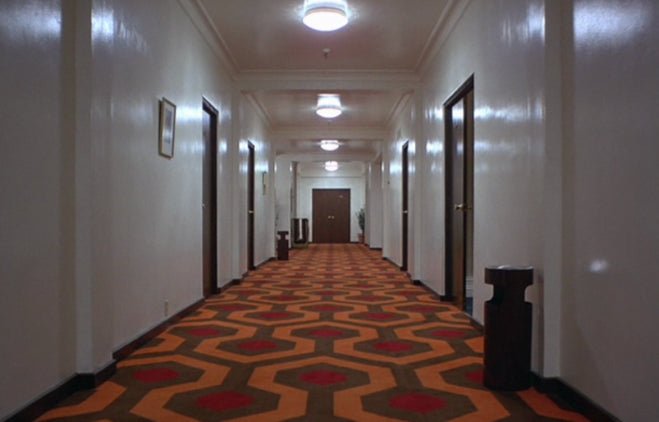
Haunting Locations from The Shining That Still Give Us Chills
Share
Stanley Kubrick's The Shining is more than just a horror movie—it's a cultural phenomenon that continues to captivate audiences with its chilling atmosphere, psychological depth, and unforgettable visuals. But what truly sets this film apart are the haunting locations that serve as the backdrop for the Torrance family's descent into madness. These places, both real and fictional, are etched into our memories, leaving us with an eerie sense of dread long after the credits roll. Let’s take a closer look at these iconic locations that still give us chills.
Timberline Lodge, Oregon: The Face of the Overlook Hotel
When you think of the Overlook Hotel, the first image that comes to mind is likely the imposing facade of the Timberline Lodge in Oregon. Perched on the slopes of Mount Hood, this remote and rugged structure was the perfect choice to represent the eerie isolation of the Overlook. Although only the exterior shots were filmed here, the Timberline Lodge has become synonymous with Kubrick’s vision of the Overlook Hotel.
Even today, visiting the Timberline Lodge can feel like stepping into the world of The Shining. The lodge's architecture, combined with its remote location, creates an atmosphere of both grandeur and unease. It's easy to imagine Jack Torrance roaming these grounds, slowly losing his grip on reality as the snow falls and the world outside becomes a distant memory.
The Ahwahnee Hotel, California: The Inspiration Behind the Overlook's Interior
While the Timberline Lodge provided the exterior, the interior of the Overlook Hotel was largely inspired by the Ahwahnee Hotel in Yosemite National Park, California. This grand hotel, with its massive stone fireplaces, towering ceilings, and Native American-inspired decor, was the blueprint for the Overlook’s opulent yet ominous interiors.
Walking through the Ahwahnee Hotel, you can almost feel the presence of the Overlook’s eerie past. The dark wood paneling, the intricate tapestries, and the expansive, dimly lit rooms all contribute to a sense of foreboding that is hard to shake. It’s no wonder Kubrick chose to replicate this setting for the Overlook—it’s the perfect blend of luxury and dread.
Elstree Studios, England: The Heart of the Overlook
While many of the locations that inspired The Shining are real, much of the film was actually shot at Elstree Studios in England. Here, Kubrick painstakingly recreated the interior of the Overlook Hotel, down to the smallest detail. From the vast, echoing Colorado Lounge to the intricate patterns of the infamous carpet, every element was designed to heighten the tension and unease that permeates the film.
Elstree Studios may no longer house the sets of The Shining, but the legacy of what was created there endures. The meticulously crafted interiors of the Overlook are a testament to Kubrick’s obsessive attention to detail and his ability to transform ordinary spaces into something deeply unsettling. Even without the context of the film, these sets exude a sense of dread that lingers long after the cameras stop rolling.
The Stanley Hotel, Colorado: The Real-Life Overlook
Before it was a movie, The Shining was a novel inspired by Stephen King’s stay at the Stanley Hotel in Estes Park, Colorado. King’s experience at the Stanley—particularly its eerie, empty halls—sparked the idea for the Overlook Hotel. Although the Stanley wasn’t used in Kubrick’s film, it has since embraced its role as the real-life inspiration for the Overlook.
Visiting the Stanley Hotel is a must for any fan of The Shining. The hotel offers ghost tours, movie screenings, and even a chance to stay in Room 217, the room that allegedly inspired King’s story. The Stanley’s old-world charm, combined with its remote location and ghostly history, makes it the perfect stand-in for the Overlook Hotel. As you wander through its halls, it’s easy to see how this place could inspire a tale of horror and madness.
The Hedge Maze: A Symbol of Madness
One of the most iconic scenes in The Shining is the chase through the hedge maze, where Jack Torrance meets his icy end. Although the maze was a set built at Elstree Studios, it remains one of the most memorable and terrifying elements of the film. The maze is more than just a physical obstacle—it’s a symbol of Jack’s descent into madness and the inescapable grip of the Overlook Hotel.
While the hedge maze doesn’t exist in real life, its impact on the film is undeniable. The maze represents the psychological horror at the heart of The Shining—the idea that once you enter the Overlook, there’s no way out. It’s a powerful metaphor for the twisted, labyrinthine nature of the human mind and the dark forces that can take hold when we’re at our most vulnerable.
How to Bring the Overlook’s Haunting Atmosphere into Your Home
For fans of The Shining who want to bring a piece of the Overlook Hotel into their own homes, there are subtle ways to capture that eerie ambiance without going overboard. Consider adding elements of dark wood, vintage decor, and dim lighting to create a space that feels both luxurious and unsettling. The goal is to strike a balance between elegance and eeriness, much like the Overlook itself.
One way to subtly evoke the atmosphere of the Overlook is through scent. A candle inspired by the Overlook Hotel can fill your space with the smoky, woodsy aroma that recalls the grandeur and mystery of the hotel. It’s a small touch that can transport you back to those haunting halls, where the line between reality and nightmare blurs.
Whether you’re a lifelong fan of The Shining or simply love the eerie, otherworldly aesthetic of the Overlook Hotel, these locations—and the atmosphere they create—continue to captivate and terrify. By exploring these places, we gain a deeper understanding of what makes The Shining such a powerful and enduring piece of cinema. And by bringing a touch of the Overlook into our own homes, we can keep that haunting legacy alive, one small detail at a time.
